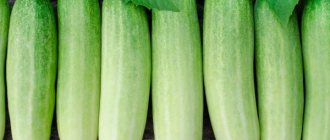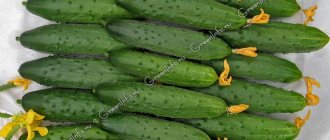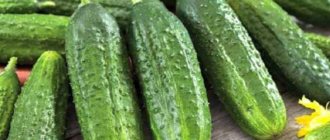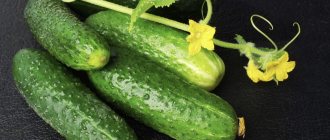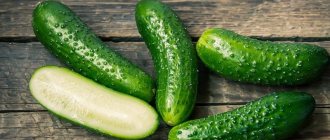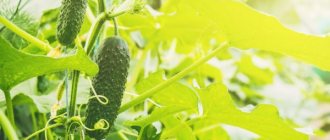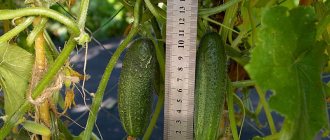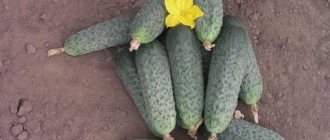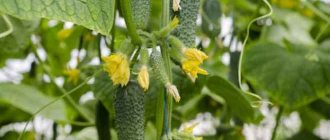Planting and care
A couple of methods are used for planting:
- Growing plants through sowing seeds.
- Growing cucumbers through seedlings.
When using greenhouses, the variety is always grown using seedlings. Before planting in the ground, experts advise warming up the seeds and soaking them in water. This variety likes to receive a lot of heat and also have normal humidity. To get the fruits of this type as quickly as possible, it is better to use greenhouses and greenhouses. If planting is carried out in open ground, then it is recommended to select a place in the garden where there will be a lot of light.
The soil should be sandy-humus, although clay-humus is suitable. The area on the site should not be heavily blown. Planting is carried out in places where potatoes, tomatoes, cabbage, as well as a variety of root vegetables and beans previously grew. It is better not to use a place in the garden where there were zucchini and similar plants.
For planting in open ground, the ideal period would be May-June, the main thing is that the ground and air temperatures return to normal. There is no need to plant cucumbers before. After sowing the soil, there is no need to water it, since the liquid will simply displace the air that is needed for growth.
Uhazher itself is an unpretentious variety, but care is necessary in order to obtain high yields. The basic rules are:
- After sowing, you need to be prepared to protect the crop from winds and possible frosts.
- To prevent bitterness in cucumbers, the soil is constantly watered, and in hot weather watering needs to be increased. Before fruiting begins, the plant needs watering every couple of days. As soon as the fruits appear, the water should become warm.
- When planting seedlings or 30 days after sowing, it is necessary to fertilize the soil. This event is held once every 2 weeks. Mineral and organic fertilizer is added, especially if the feeding was of poor quality at the time of sowing.
- When thinning is completed, it is once again necessary to feed the soil and also do a little digging, which allows the roots to grow and develop.
During cultivation, the plant needs protection from pests. For complete protection use:
- After flowering, spraying with Ridomil is necessary.
- The complex of Oxychom and Actellik products helps growth well.
- With the onset of summer, you need to treat the plants with Fitoverm.
- 20 days before the start of harvesting, cucumbers are sprayed with Abiga Peak.
The trellis method is ideal for growing, which simplifies care, increases productivity, and reduces the risk of disease.
Care
Uhazher cucumbers bring a high yield if they receive the necessary care. Plantings are watered and fed. With regular care, the likelihood of the spread of diseases and pests is reduced.
Watering
The watering scheme for Uhazher cucumbers depends on the stage of their development:
- before the buds appear - 3 liters of water under the bush weekly;
- during flowering and fruiting - 6 liters every 3 days.
Before irrigation, water is poured into barrels to increase its temperature. Moisture is brought in by the indoor or evening hours. It is important to avoid contact of water with the roots and leaves of cucumbers. To prevent jets of water from eroding the soil, use watering cans with spray nozzles.
After adding moisture, the soil under the cucumbers is loosened and weeds are removed. Loosening improves the absorption of moisture and nutrients. In hot weather, do not allow a crust to form on the surface of the soil.
Feeding
Cucumbers of the Ukhazher variety are fed according to the following scheme:
- 2 weeks after transfer to the ground;
- during the formation of buds;
- during fruiting.
In hot weather, root feeding is effective because plants actively absorb nutrients from the soil. In cool weather, they switch to foliar treatments.
A universal fertilizer for cucumbers is a solution of mullein or bird droppings in a ratio of 1:15. For 1 m2 of plantings with cucumbers, apply 4 liters of liquid fertilizer.
To spray Ukhazher cucumbers, use complex fertilizer. The solution can be prepared by mixing 15 g of urea, 25 g of potassium sulfate and 30 g of superphosphate. Foliar treatment is carried out in the morning or evening in the absence of direct sunlight.
Minerals are replaced with wood ash. It is added to the water a day before watering or embedded in the soil. Wood ash not only saturates the soil with nutrients, but also repels pests.
Bush formation and tying
According to the description, the Ukhazher cucumber variety is not prone to strong branching and does not require additional formation. It is enough to pinch the stepsons and ovaries growing under the 3rd leaf.
As cucumbers grow, they need staking. The procedure does not allow the plantings to become overgrown and simplifies care and harvesting.
In a greenhouse or in an open area, supports are driven in, between which wire or thin twine is pulled.
Protection from diseases and pests
The Ukhazher variety is resistant to root rot, powdery mildew and downy mildew. For prevention, cucumbers are treated with Fitosoprin, Oxykhim, and Topaz. The products are diluted with water according to the instructions and are not used during the fruiting period.
The risk of developing diseases can be reduced by following agricultural practices:
- compliance with crop rotation;
- use of quality seeds;
- watering rationing;
- ventilation of greenhouses and greenhouses with cucumbers.
Among the folk methods of fighting diseases, infusions of onion peels and garlic are effective. They are used for spraying cucumbers. To make the infusion stay on the leaves longer, add a little crushed soap to it.
The pungent smell of garlic and onions repels aphids, spider mites, thrips and other pests. A more radical way to get rid of insects is to use insecticides.
Pest treatment
The cucumber variety Uhazher f1, like any other, can be affected by pests, namely:
- spider mite;
- melon aphids;
- whitefly;
- slugs.
Spider mite
If yellow dots and barely visible cobwebs become noticeable on the leaves, a spider mite has infested the plant. Since it loves low humidity, the first remedy against the pest is to spray the leaves in hot weather up to several times a day.
An infusion of onion or garlic also comes to the rescue. It is used several times during the summer. Dill is planted next to cucumbers: it attracts ladybugs, which are the enemies of ticks. Planting seedlings as early as possible reduces the risk of infection. Another option is to treat plants with insecticides.
melon aphid
To combat melon aphids, first of all, it is necessary to keep the beds clean and remove any remaining vegetation for the winter. Plants are treated with infusions of celandine, onions, and potatoes. An infusion of tree resin also helps. Sometimes pesticides are used.
Cucumber Suitor F1. GavrishCucumber varieties Super productive! both for open and indoor greenhouses!!! The best varieties of cucumbers! The first cucumbers in the south of the region (Yenisei Minusinsk)
Whitefly
Glue traps help in the fight against whiteflies. Garlic or onion infusion is also used. If necessary, use pesticides.
Slugs
To get rid of slugs, use an infusion of hot pepper. Spruce and pine needles, which are added to the soil around the cucumbers, also help well. Another option is a solution of ammonia. In some cases, chemicals are used.
Disease and pest control
Cucumber Suitor can be affected by the following pests:
- spider mite;
- melon aphid;
- whitefly;
- slugs
The mite entangles the plant in a barely noticeable web, and because of it the leaves become covered with yellow dots. Spraying foliage in hot weather is the first remedy against these pests. Dill is also planted next to the crop: it attracts ladybugs, which love to feast on ticks.
Melon aphids are removed with infusions of onions, celandine or potatoes. In advanced cases, chemicals are used. To prevent diseases, it is necessary to keep the beds clean.
Whiteflies are controlled with glue traps. Hot pepper tincture helps against slugs. In addition, spruce or pine needles are buried in the soil around the plant.
Cucumber care
How to grow cucumbers without hassle? To do this, the bushes should be regularly looked after and inspected for the appearance of insects or diseases.
Proper planting of seedlings in open ground:
- Dig up the soil and apply mineral fertilizers (you can use organic matter);
- Mix the soil and make beds;
- You can plant seedlings only if the first full leaves have appeared on them;
- Plant the bushes without deepening the stem;
- Water the seedlings with warm water and potassium permanganate;
- Cover the bushes with a warm cloth at night to protect them from night frosts.
Mineral and organic fertilizers need to be added to the soil every two weeks. This will stimulate the growth of shoots and ovaries. If the bushes are overfed, they will begin to actively grow leaf mass. Then you can stop feeding. It is advisable to water the plants only with warm water, otherwise they may get sick and die.
Description of cucumbers
Uhazher is a mid-early hybrid that is recommended to be grown in seven regions of Russia: Middle Volga, Central Black Earth, Central, Volga-Vyatka, North Caucasus, North-West and North.
Its early ripening helps to avoid diseases and the negative effects of insect pests.
Distinctive features
The fruits differ from other types of cucumbers in the following ways:
- cucumbers are covered with tubercles with white spines;
- the skin is thin, bright green with white stripes;
- large size: length from 15 to 18 cm, diameter up to 4 cm;
- cylindrical shape;
- weight from 180 to 200 g.
In the photo there is a cucumber Uhazher.
Properties, benefits, calorie content
Cucumber is a dietary product that is 95% water and contains 15 kilocalories per 100 g of product. It contains vitamins, fiber, organic acids and other beneficial substances. The presence of a large amount of water in the vegetable helps remove toxins and waste from the body, cleanse the kidneys and liver of heavy metal salts.
Fiber, which is present in large quantities in fruits, cleanses the stomach and improves intestinal function. Cucumber contains beta-carotene, magnesium, potassium, zinc, folate and other minerals.
Cucumber perfectly quenches thirst, improves appetite, and helps digest food. The dietary product is used in various recipes for weight loss.
Characteristics of the Uhazher hybrid
Cucumber is pollinated by bees, grows on loamy-humus or sandy loam soils, is resistant to low temperatures, and does not require special care. The fruit ripening period is medium-late, from 55 to 60 days.
The main characteristic features of the Suitor:
- the root system is voluminous, absorbs moisture from the soil well, reaches 30 cm in depth;
- the bush is large, low, with male and female inflorescences;
- the stem is strong, powerful, with a climbing pattern from 60 cm to 1.5 meters;
- the leaves are large, dark green, smooth, wavy at the edges; arranged alternately on the stem;
- the taste is pleasant, sweetish;
- the yield is high - up to 6 kg are harvested from one bush, from 1 sq. m up to 16 kg of cucumbers;
- the seeds are oblong and milky cream in color.
Planting rules and care
During planting, you need to consider some requirements:
The area should be well lit. Loamy-humus and sandy loam soil is suitable as soil. Cucumbers are afraid of drafts and strong winds, so you need to protect them as much as possible from these phenomena. It is important to avoid low-lying areas, as they are characterized by reduced temperatures and accumulation of moisture. The bed is considered ideal at a height of 30 cm, which is located from east to west. In the autumn, humus, sawdust and peat are introduced into the soil. Cucumbers are planted on the soil where potatoes, broccoli, tomatoes, and legumes previously grew.
Cucumbers are planted on the soil where potatoes, broccoli, tomatoes, and legumes previously grew.
It is better to avoid places where zucchini, pumpkin and eggplants were planted. After these crops, the likelihood of contracting a disease increases, which will negatively affect the harvest.
Irrigation scheme:
- Before the first inflorescences appear, water the bush weekly using three liters of water;
- After fruit formation, the crop is watered every three days, using up to 6 liters of water.
For irrigation use warm, rain or settled water.
Fertilize regularly, taking into account the temperature conditions. In hot weather, root fertilizers are used, in cold weather, foliar fertilizers are used.
The best fertilizer for cucumbers is considered to be bird droppings and mullein solution, proportion 1 to 15. By following all these recommendations, you can count on good and long-term fruiting.
Useful tips on caring for cucumbers, watch the video:
Gherkin cucumbers - varieties
First, let's look at the difference between crispy gherkins and other varieties. The word “cornichon” is translated extremely simply and means “cucumber”. This popular name was invented by the French, it caught on and quickly became fashionable in other countries. Standard gherkin cucumbers for open ground can be obtained by removing young juicy greens up to 9 cm long from ordinary bushes. Smaller cucumbers measuring from 3 cm to 5 cm are called pickles.
Reputable vegetable growers and chefs say that it is better to purchase special small-fruited varieties of gherkin cucumbers for sowing, intended for pickling, characterized by improved characteristics. Their fruits are crispy and do not form a cavity inside when ripe. When ripe, gherkins do not grow to enormous sizes; they are always easily placed in jars or used for processing into salads.
The most popular cucumbers are gherkins:
- Parisian gherkin,
- Funny company,
- Moth F1,
- Marinade F1,
- Moravian gherkin,
- Children's,
- Philippok F1,
- Sweet crunch
- Son of the F1 regiment,
- Beloved son-in-law F1,
- Brownie F1.
It is recommended that instead of old varieties, purchase hybrid gherkin cucumbers, which produce mini fruits suitable for harvesting at a very early stage. These plants have a predominantly female flowering type and form even green foliage. Their one- or two-day-old ligature reaches a length of up to 4 cm and is excellent for processing. It is not thin, tasteless “pencils”, but juicy, high-quality cucumbers.
Cucumber Moravian gherkin
Listing the best varieties of gherkin cucumbers, we can highlight the Moravian gherkin F1, which is distinguished by excellent characteristics. By growing this hybrid, you will receive a stable production of smooth marketable fruits without bitterness, weighing 68-94 g, resistant to major diseases. The yield of bushes reaches 8 kg/m2. The average growing season is 45 days. Seeds are sown at a planting density of up to 5 sprouts per 1 m2.
Cucumber variety Parisian gherkin
You can’t miss the famous Parisian gherkin cucumbers; the description of the French variety will appeal to most gardeners who want to get a stable harvest of vegetables on their plot every year. The shape of the greens is spindle-shaped, they weigh about 57-78 g, the ripening period is about 45 days. The crunchy fruits with large tubercles have a characteristic dark fluff; when they ripen, no bitterness appears in the taste.
Agricultural technology and proper cultivation
“Uhazher” is intended for cultivation in greenhouses and stationary greenhouses in small households. Sowing of seedlings is carried out in April. Sowing without seedlings in a greenhouse is carried out in May, when the soil temperature does not drop below 14*C.
Plants do not tolerate dense planting well, so the density of planting should not exceed 2.5 plants per 1 sq.m.
Vigorous plants of this cucumber require high-quality and regular pinching. The bushes form strictly into one stem. All stepsons and ovaries below the 4th node must be removed. The growth stem is pinched after twisting onto the top crossbar of the trellis.
The rest of the care is standard:
- Moderate watering to prevent the soil from drying out;
- Fertilizing with alternating organic and mineral complexes up to 4 times per season;
- Loosening the soil and weeding.
Brief information about the variety
- Fruits and bush: green cucumbers, 15-18 cm long. The bush is indeterminate (unlimited growth of the main vine).
- Productivity: 4-6 kg per plant.
- Resistance: to frosts and autumn cold spells. Resistant to powdery mildew, cucumber mosaic and root rot.
- Distribution: suitable for all regions, but in the middle zone and northern regions the variety is cultivated in greenhouse conditions and planted in heated soil.
- Application: suitable for both fresh consumption (in salads) and canning.
- Planting: seeds in open ground and seedlings. They are planted in the soil in April, and for seedlings in March-April. Planting pattern – 50x50.
- Soil: loamy-humus or sandy loam.
- Care: fertilizing and watering are carried out in three stages - after planting, during budding, during fruiting. Bush formation is not required.
- Ripening period: the crop ripens in late summer. Fruiting lasts until the first frost. It is possible to store cucumbers for a long time.
Characteristic
The Uhazher variety has many positive characteristics, but first of all it is worth paying attention to the yield indicators, flowering and fruiting times of cucumber bushes.
Find out the benefits and harms of cucumbers.
Flowering and fruiting times
The first harvest of Ukhazhir cucumbers is harvested approximately 55–60 days after emergence, that is, at the end of July or beginning of August. If you sow the seeds in time a second time, then in greenhouse conditions it will be possible to harvest two crops per year. Flowering of cucumber bushes is observed approximately 1–1.5 months before harvesting the greens.
Productivity
In good growing conditions, it is quite possible to harvest about 5–6 kg of greens from one cucumber bush, while the marketable yield of 1 m² of plantings is at least 15–16 kg. Fruiting is extended over time and in some cases continues until frost.
Resistance to pests and diseases
Like most other hybrid crops, cucumbers of the Ukhazher variety have increased resistance to typical diseases and are not afraid of diseases (powdery mildew, root rot, cucumber mosaic). This means that even without the use of fungicidal and insecticidal compounds, you have every chance of getting a high-quality harvest, without chemical impurities.
Important! To start collecting Uhazhior cucumbers, you do not have to wait until they reach their maximum size. Small specimens also taste good, the main thing is
-
promptly remove the skin with a large number of small spines.
In addition, high resistance to disease is maintained even during long-term storage of the collected fruits: they do not rot or spoil, and their peel retains its integrity even during long-term transportation of the greens.
How to care for plants
Watering should be regular and plentiful, otherwise the greens will acquire a bitter taste. The frequency of watering should be as follows: before fruiting begins, cucumbers need to be watered every two or three days (depending on weather conditions), and during the period of fruit growth, you will need to switch to daily watering. If the days are hot and dry, watering is required 2 times, in the morning and in the evening.
After the cucumbers have been planted in a permanent place, they need to be fertilized. Their frequency is once every 2-2.5 weeks. It is best to apply fertilizers together with watering, this way all valuable substances will reach the roots in the shortest possible time.
Fertilizers need to be alternated: first mineral, then organic.
Since these cucumbers of the Uhazher F1 variety are susceptible to diseases and pest attacks, they need to be processed periodically. Time of processing:
- immediately after flowering;
- approximately a month before the expected harvest.
A week before harvesting, there is no need to carry out any treatments, as chemicals may get on the fruits.
Description of the cucumber variety “Uhazher f1”
Short review:
“Uhazher F1” is a first-generation hybrid bred by breeders of the All-Russian Research Institute of Vegetable Growing (FGBNU VNIIO) - A.V. Shamshin, S.F. Gavrish and A.E. Portyankin. Agro supplies the seed market.
Based on the ripening period, this cucumber is classified as medium-late. Fruiting occurs 55-60 days after sowing. Despite the fact that the plants are intended for cultivation in greenhouse conditions, the hybrid belongs to traditional pollinated crops. Plants are indeterminate with medium climbing habit. The leaves are large, the color is dark green.
Among other hybrids offered by agro, the most in demand are:
- “Courage F1” is a greenhouse high-yielding cucumber (ripening period is 45-50 days);
- “Emerald earrings F1” is an indeterminate, vigorous hybrid with a large number of ovaries in one node (up to 10 pieces);
- “Crispy bed F1” is a universal gherkin with abundant fruit set (up to 12 in a node) and uniform fruiting;
- “Liliput F1” is an early ripening hybrid that produces up to 11 kg/sq.m of selected pickles.
Fruit
Cucumbers are large – 14-18 cm long and weighing up to 200 grams. The shape of the fruit is classic oblong, with a short neck and a large number of tubercles. The skin is dark green with faint stripes and pronounced ribbing. The pubescence is white.
Description of the variety
Cucumbers of the Ukhazher variety are mid-season, medium-climbing plants. There are few side shoots on the plant - 2-3, no more. The leaves on the bushes are large, with slight wavy edges. The type of flowering is both male and female, that is, mixed. Since the plant is mid-season, the fruits can be harvested 55-60 days after emergence. About 2-3 ovaries are formed on one node.
The description of the fruits of this variety is as follows:
- length – 16-18 cm;
- diameter – 3.5-4 cm;
- weight – 180-210 g.
Large tubercles and white spines are clearly visible on the fruits. The shape of the greens is regular, oval (see photo). Cucumbers have an excellent presentation and good transportability. They can be stored for quite a long time without losing their attractiveness. The taste characteristics of the variety are excellent, both fresh and canned. On top of that, the Uhazher cucumber is extremely disease-resistant; it is not afraid of powdery mildew (both real and downy), root rot and cucumber mosaic.
Characteristics of the variety
According to the description of the cucumber variety Uhazher, the plant is not capricious, bee-pollinated, the bush has male and female flowers. From the moment the first shoots appear until the fruits are harvested, it can take about 57 days. The variety does not require special care.
Description of fruits and bush
The culture is vigorous, large, indeterminate. The green leaves are powerful and smooth. The leaf axil forms from one to three ovaries.
Description of the fruit of the Ukhazher variety: regular cylindrical shape, with white thorns on large tubercles. Length – from 15 to 18 cm, diameter – 4.5 cm. Pubescence on cucumbers is rare.
Productivity
Up to 6 kg of fruits are obtained from one plant. Suitor f1 is resistant to weather changes, so it can easily withstand autumn temperature changes and can bear fruit until cold weather. With proper care, the amount of harvest can increase.
Area of application of fruits
This variety of cucumber is great for salads and canning. The fruits are not hollow. When canning or pickling, they remain crispy, and the brine does not get inside the cucumbers. The twists have a long shelf life, and the fruits do not lose their crunchy properties.
Advantages and disadvantages of the variety
The main advantage of cucumbers of the described variety is their delicate taste and crispy flesh, although in addition to these characteristics they have something to surprise the gardener.
- The general advantages of the Suitor include the following features:
- long period of fruiting (often until frost);
- high yield rates;
- excellent commercial quality of fruits;
- the possibility of long-term storage of the harvested crop and long-term transportation;
- good resistance to diseases and pests;
- low maintenance requirements.
As for the disadvantage of these fruits, some vegetable growers attribute them to the presence of a large number of prickly thorns on the peel, which have to be brushed off before use.
Landing
When the third leaf appears, the seedlings can be planted
The hybrid can be grown either by seedlings or by planting seeds in open ground. If you plant a crop in greenhouses, it is better to first grow seedlings. In protected soil it will be stronger and more productive.
Seedlings are planted in open ground at the end of May or at the beginning of June, as soon as they have 2-3 true leaves.
Seeds in the ground
In mid-April, the soil should be dug up and leveled. In May, humus and mineral fertilizers are added to the soil. The soil is disinfected with a weak solution of potassium permanganate and covered with a dark film. For planting, you should choose a warm day when the ground is warm and there is no chance of night frosts.
For seedlings
Seeds are planted for seedlings in March-April. First they are disinfected. This treatment will help protect the plant from diseases. Place one seed at a time in prepared peat-humus containers. The use of individual cups will help you avoid picking.
You can make the substrate yourself: for this you take compost, peat and sawdust in a ratio of 2:2:1. Seeds are not planted deep. Watering is carried out with warm water and the temperature is maintained at 23-25 °C. To increase it and create a greenhouse effect, the containers are covered with film. Periodically provide air supply to the seedlings.
Ukhazher f1 cucumber seedlings are planted in a permanent place of growth in May-June. The sprouts are ready for transplanting when they have 3-4 leaves. The landing site should be well lit and protected from the wind.
Every day, 3 liters of water are poured under the bush until the buds appear. During flowering and fruiting, pour 6 liters under the bush every 3 days. Watering is carried out in the morning or evening. To prevent soil erosion, watering cans with sprayers are used.
Feeding is carried out in three stages:
- a couple of weeks after planting the plant in the soil;
- at the stage of bud formation;
- in the fruiting phase.
Root feeding is carried out in hot weather, at which time Uhazher f1 cucumbers actively draw nutrients from the soil. On cool days, it is better to use foliar feeding.
With good care you can get a rich harvest
According to its characteristics, the variety is not highly branched, so the bush does not require formation. It is only necessary to pinch the ovaries and stepsons under the third leaf. They garter cucumbers: this helps to care for them and harvest.
Growing cucumbers
The Uhazher cucumber variety is recommended to be grown under film cover. The most reliable way is to obtain seedlings at home. According to reviews and photos in the southern regions, the Uhazher F1 cucumber is successfully developing in open areas.
Planting seeds
Seeds of the Ukhazher variety are planted for seedlings in March-April. Planting material is disinfected by placing it in a Fitosporin solution. Treatment will help prevent the spread of diseases in the future.
Advice! When the cucumber seeds swell, they are wrapped in a damp cloth for 2 days. The material is periodically moistened to prevent it from drying out.
Uhazher cucumber seeds are planted in ready-made peat-humus cups. One seed is placed in each of them. Using separate containers allows you to avoid picking cucumbers.
You can prepare a substrate for cucumbers yourself from compost, peat and sawdust in a ratio of 2:2:1. For 5 liters of mixture add 1 tbsp. l. nitrophoska and wood ash. The containers are filled with soil mixture.
Uhazher cucumber seeds are not planted deeply; it is enough to add a layer of soil 5 mm thick. Plantings are watered with warm water and kept at a temperature of 23-27 °C. To increase the temperature and create a greenhouse effect, the containers are covered with film. It is turned over periodically to ensure the supply of fresh air.
Seedling care
After germination, Ukhazher cucumbers are provided with a number of conditions:
- daytime temperature +20 °C;
- night temperature +16 °C;
- lighting for 12 hours;
- regular addition of moisture.
If necessary, phytolamps or fluorescent devices are installed above the cucumber seedlings. Lighting is turned on in the morning and evening.
Uhazher cucumber plantings are watered with warm, settled water every week. Moisture is applied at the root. It is most convenient to use a spray bottle. Excess water is poured out.
When plants form 1-2 leaves, they are picked into separate containers or peat tablets. After transplantation, the temperature in the room is reduced to +17 °C for several days.
Landing in the ground
Seedlings of the Ukhazher variety are transferred to a permanent place at the end of May or beginning of June. Plants with 3-4 leaves are subject to transplantation.
The place for growing cucumbers is prepared in the fall. The area should be well lit by the sun and protected from the wind. Plants prefer fertile, permeable soil with minimal nitrogen content.
In the fall, when digging up beds for cucumbers, you need to add peat, humus and a little sawdust. Low-lying areas where moisture and cold air accumulate are not suitable for planting Ukhazher cucumbers. Cucumbers grow well in beds 30 cm high, located from east to west.
Attention! The best predecessors for cucumbers are tomatoes, cabbage, onions, and perennial herbs. Planting after pumpkin crops is not recommended.
According to the description of the variety from the manufacturers, Ukhazher cucumbers are planted in a permanent place according to a 50x50 cm pattern. The plants are transferred together with a peat cup to the planting hole. The roots are covered with a mixture of soil and humus. After planting, 3 liters of moisture are added to each plant.
Planting seeds for seedlings
Before planting seeds, you need to decide in which containers it will be planted. Many gardeners use plastic jars or compact wooden boxes sized to fit the windowsill.
Planting in special peat pots guarantees minimal trauma to the root system during transplantation. These containers are designed to be moved into the ground along with the plant.
The second stage of work is preparing the optimal soil, which in chemical composition should be similar to the one where the plant will develop after transplantation. In specialized stores you can purchase ready-made soil mixture for cucumbers or prepare temporary soil yourself. To do this you need to mix:
- chernozem 10 l;
- humus 3 l;
- wood ash 250 g;
- medium-grained sand 2 l;
- double superphosphate 2 tbsp;
- potassium sulfate 1 tbsp.
Seeds that are suitable for further planting
Seedlings are planted 20-25 days before the expected transplant date. During transplantation, the average daily air temperature should be at least +20° C.
2 seeds are planted in one container, laying them flat sideways at a depth of 1-2 cm. After this, the soil is pinched and sprayed with water using a spray bottle, subsequent watering must be provided every 2 days. After the cotyledon leaves appear, the weaker plant is removed.
For active development of seedlings, good lighting is required without direct sunlight. In darkened rooms, it is recommended to enhance diffused daylight with lamps and mirrors that reflect the sun's rays. A good impetus for the development of seedlings is given by fertilizing with a solution of nitrophoska (3 tsp) and water (3 l).
Many gardeners harden off a young plant by taking it out into the fresh air for 3-4 hours during the last week before replanting.
Planting a variety
The Ukhazher cucumber, like other varieties, is highly sensitive to cold, so during planting the soil temperature should reach 17-18°C. In the fall, the site is dug up and all remnants of vegetation are removed. Acidic soil is limed.
Sowing method
In the spring, around mid-April, the ground is dug up again and leveled with a rake. After waiting until mid-May, humus is added, as well as mineral fertilizers and wood ash. The soil is treated with a solution of potassium permanganate (so the seeds, and later the sprouts, will be protected from diseases), then covered with a dark-colored film.
Choose a warm day for sowing seeds. The seeds are sown to a depth of no more than 1.5-2 cm. After germination, the bed is thinned out, leaving the strongest plants. The distance between them should be about 20-25 cm.
Seedling method
The seedling method allows you to speed up the fruiting process by a couple of weeks.
Cucumber Uhazher f1 is sown as seedlings and a month later they are planted on the site, adhering to a number of rules:
- Fill cups about 9 cm deep with light and fertile soil and sow at a distance of approximately 1.5-2 cm from the surface;
- planting in the ground is carried out when the temperature at night is not lower than 14°C, during the day - 18-20°C;
- water the ground 2 times a week, in the morning, with warm, settled water;
- don't forget to use fertilizers;
- 10 days before planting, seedlings begin to harden on the site.
How to grow your own
The suitor is grown in two ways - seedlings or direct planting in the ground. It is better to plant a plant that will ripen indoors using the seedling method. In warm regions, seeds are sown in the ground.
Seedling method
Before planting seeds for seedlings, it is recommended to pre-germinate the seeds. Then the plant will take root better in the ground, and the first shoots will appear faster. Seeds for seedlings are prepared in the following ways:
- First they are selected and calibrated. Discard damaged, small seeds so that the seedlings grow evenly. To separate bad seeds from good ones, it is advised to put them in a saline solution (dissolve two tablespoons of salt in a liter of water) - bad quality seeds will float to the surface.
- Then they warm up. They are placed in a linen or cotton bag and placed in a place where sunlight hits or on a battery. Warm the seeds for several days, shaking the bag regularly to mix them.
- Next they are disinfected. Seeds are disinfected with a 1% manganese solution for 20 minutes, and with 3% hydrogen peroxide for 10 minutes. A solution of boric acid helps in treating seeds - half a teaspoon is dissolved in a glass of water, copper sulfate - a quarter of a teaspoon is added to a glass of water. Soak cucumber seeds in one of these solutions for up to three hours. It is recommended to use fungicides: Fitosporin-M, Trichodermin. Among folk remedies, aloe juice and garlic solution are used.
- Afterwards, plant growth is stimulated by soaking the seeds in the chemical preparations “Gumi” and “Epin-Extra”.
After swelling, the seeds are placed in a damp natural cloth for two days and wrapped. It is periodically moistened with water to provide moisture to the seeds. They are planted for seedlings at the end of March - beginning of April in peat pots.
To avoid pruning the plant, one seed is placed in each of them. The mixture for future seedlings is prepared independently from humus, peat, sawdust in a ratio of 2:2:1.
How to plant Uhazher cucumbers
This hybrid variety of cucumbers can be grown in two ways - by direct planting of seeds in the ground or by seedlings. If planting will be done in greenhouses or greenhouses, then it is best to resort to the seedling method. This way the plants will grow stronger and more productive. Seedlings are planted in the ground in May-June, and only after 2-3 true leaves appear on it.
Cucumbers love sunlight and good soil - sandy loam or loamy humus. It is necessary to choose a place for planting so that the plants are maximally protected from wind and drafts.
Much attention should be paid to what has grown in the beds up to this time. The best predecessors of cucumbers are legumes, potatoes, tomatoes or broccoli.
The worst are zucchini, eggplant and pumpkins, that is, it is not recommended to plant cucumbers after these vegetables. The plantings will either give a poor harvest or contract diseases whose virus remained in the ground after the said vegetable crops.
Cucumber Suitor F1
Uhazher cucumber is a reliable hybrid variety adapted to unfavorable conditions.
It is valued for its extended fruiting, unpretentiousness and high yield. The variety is used for preparing salads or fresh. To obtain a high yield, the seedling method of growing crops is used. When planted in a greenhouse, cucumbers are harvested before the autumn cold snap. The Uhazher cucumber was bred by Russian breeders. The hybrid was included in the State Register in 2004 and is recommended for planting in the central zone, the Volga region, the North Caucasus, and the Northern and Northwestern regions.
Description of the variety and photo of the Uhazher cucumber:
- mid-late ripening;
- the period from germination to fruit harvesting takes 55-60 days;
- pollinated by bees;
- mixed type of flowering (have female and male flowers);
- powerful plant;
- average ability to form shoots;
- large dark green leaves.
The fruits of the Ukhazher variety have a number of features;
- large tuberous cucumbers;
- rich green color;
- cucumber length from 18 to 20 mm;
- diameter 4 cm;
- weight about 200 g;
- thin skin;
- white thorns.
From one bush of the Ukhazher variety, 5-6 kg of cucumbers are harvested. Productivity depends on the method of cultivation and climatic conditions of the region. The variety is recommended for planting in a greenhouse or greenhouse. In warm climates, plants are planted in open areas.
Uhazher cucumbers are used fresh, added to salads, appetizers, side dishes and other dishes. When chopped, the variety is suitable for preparing assorted vegetables and canned salads.
Fruiting of Uhazher cucumbers lasts for a long time, until the onset of autumn frosts. The variety tolerates cold weather well.
Seeds from the companies Gavrish, Zolotoy Altai, Good Seeds, Aelita, and Harvest of Good Luck are available for sale. Planting material is packaged in packs of 10 pieces.
The Uhazher cucumber variety is recommended to be grown under film cover. The most reliable way is to obtain seedlings at home. According to reviews and photos in the southern regions, the Uhazher F1 cucumber is successfully developing in open areas.
Seeds of the Ukhazher variety are planted for seedlings in March-April. Planting material is disinfected by placing it in a Fitosporin solution. Treatment will help prevent the spread of diseases in the future.
Advice! When the cucumber seeds swell, they are wrapped in a damp cloth for 2 days. The material is periodically moistened to prevent it from drying out.
Uhazher cucumber seeds are planted in ready-made peat-humus cups. One seed is placed in each of them. Using separate containers allows you to avoid picking cucumbers.
You can prepare a substrate for cucumbers yourself from compost, peat and sawdust in a ratio of 2:2:1. For 5 liters of mixture add 1 tbsp. l. nitrophoska and wood ash. The containers are filled with soil mixture.
Uhazher cucumber seeds are not planted deeply; it is enough to add a layer of soil 5 mm thick. Plantings are watered with warm water and kept at a temperature of 23-27 °C. To increase the temperature and create a greenhouse effect, the containers are covered with film. It is turned over periodically to ensure the supply of fresh air.
After germination, Ukhazher cucumbers are provided with a number of conditions:
- daytime temperature +20 °C;
- night temperature +16 °C;
- lighting for 12 hours;
- regular addition of moisture.
If necessary, phytolamps or fluorescent devices are installed above the cucumber seedlings. Lighting is turned on in the morning and evening.
Uhazher cucumber plantings are watered with warm, settled water every week. Moisture is applied at the root. It is most convenient to use a spray bottle. Excess water is poured out.
When plants form 1-2 leaves, they are picked into separate containers or peat tablets. After transplantation, the temperature in the room is reduced to +17 °C for several days.
Seedlings of the Ukhazher variety are transferred to a permanent place at the end of May or beginning of June. Plants with 3-4 leaves are subject to transplantation.
The place for growing cucumbers is prepared in the fall. The area should be well lit by the sun and protected from the wind. Plants prefer fertile, permeable soil with minimal nitrogen content.
In the fall, when digging up beds for cucumbers, you need to add peat, humus and a little sawdust. Low-lying areas where moisture and cold air accumulate are not suitable for planting Ukhazher cucumbers. Cucumbers grow well in beds 30 cm high, located from east to west.
Attention! The best predecessors for cucumbers are tomatoes, cabbage, onions, and perennial herbs. Planting after pumpkin crops is not recommended.
According to the description of the variety from the manufacturers, Ukhazher cucumbers are planted in a permanent place according to a 50x50 cm pattern. The plants are transferred together with a peat cup to the planting hole. The roots are covered with a mixture of soil and humus. After planting, 3 liters of moisture are added to each plant.
Uhazher cucumbers bring a high yield if they receive the necessary care. Plantings are watered and fed. With regular care, the likelihood of the spread of diseases and pests is reduced.
The watering scheme for Uhazher cucumbers depends on the stage of their development:
- before the buds appear - 3 liters of water under the bush weekly;
- during flowering and fruiting - 6 liters every 3 days.
Before irrigation, water is poured into barrels to increase its temperature. Moisture is brought in by the indoor or evening hours. It is important to avoid contact of water with the roots and leaves of cucumbers. To prevent jets of water from eroding the soil, use watering cans with spray nozzles.
After adding moisture, the soil under the cucumbers is loosened and weeds are removed. Loosening improves the absorption of moisture and nutrients. In hot weather, do not allow a crust to form on the surface of the soil.
Cucumbers of the Ukhazher variety are fed according to the following scheme:
- 2 weeks after transfer to the ground;
- during the formation of buds;
- during fruiting.
In hot weather, root feeding is effective because plants actively absorb nutrients from the soil. In cool weather, they switch to foliar treatments.
A universal fertilizer for cucumbers is a solution of mullein or bird droppings in a ratio of 1:15. For 1 m2 of plantings with cucumbers, apply 4 liters of liquid fertilizer.
To spray Ukhazher cucumbers, use complex fertilizer. The solution can be prepared by mixing 15 g of urea, 25 g of potassium sulfate and 30 g of superphosphate. Foliar treatment is carried out in the morning or evening in the absence of direct sunlight.
Minerals are replaced with wood ash. It is added to the water a day before watering or embedded in the soil. Wood ash not only saturates the soil with nutrients, but also repels pests.
According to the description, the Ukhazher cucumber variety is not prone to strong branching and does not require additional formation. It is enough to pinch the stepsons and ovaries growing under the 3rd leaf.
As cucumbers grow, they need staking. The procedure does not allow the plantings to become overgrown and simplifies care and harvesting.
In a greenhouse or in an open area, supports are driven in, between which wire or thin twine is pulled.
The Ukhazher variety is resistant to root rot, powdery mildew and downy mildew. For prevention, cucumbers are treated with Fitosoprin, Oxykhim, and Topaz. The products are diluted with water according to the instructions and are not used during the fruiting period.
The risk of developing diseases can be reduced by following agricultural practices:
- compliance with crop rotation;
- use of quality seeds;
- watering rationing;
- ventilation of greenhouses and greenhouses with cucumbers.
Among the folk methods of fighting diseases, infusions of onion peels and garlic are effective. They are used for spraying cucumbers. To make the infusion stay on the leaves longer, add a little crushed soap to it.
The pungent smell of garlic and onions repels aphids, spider mites, thrips and other pests. A more radical way to get rid of insects is to use insecticides.
Svetlana, 37 years old, Rostov region Every year I try to buy new varieties of cucumbers. I grow them in open ground. Last year I purchased Ukhazher cucumber seeds based on the description of the variety and photo. The variety fully met expectations. In open ground there were no problems with pollination. Cucumbers go well in salads. Part of the harvest is sent for sale and is sold out very quickly. Evgeniy, 48 years old, Tula I bought Ukhazher F1 cucumber seeds based on reviews and photos. Late ripening variety, pollinated by bees. The taste is excellent, we use it mainly for salads. When growing the variety Uhazher noticed that many male flowers were growing. Next year I plan to use it to pollinate other varieties of cucumbers with female flowering. Marina, 52 years old, Novosibirsk Ukhazher cucumber is my favorite salad variety; I have been planting its seeds for 4 years in a row. It grows well in a greenhouse, pollination occurs due to insects. To attract bees and wasps, I planted several marigolds in the greenhouse. The fruit tastes sweet, the skin is thin and not bitter. In closed ground it bears fruit until October, even when the temperatures outside are already sub-zero. Uhazher is a very cold-resistant variety, recommended for growing in unstable climatic conditions.
Uhazher cucumber is a proven salad variety that produces high yields even in harsh conditions. Caring for the variety includes watering and fertilizing. Uhazher cucumbers are resistant to diseases and tolerate lack of heat well. If the rules of care are followed, they will not show signs of fungal infections.
